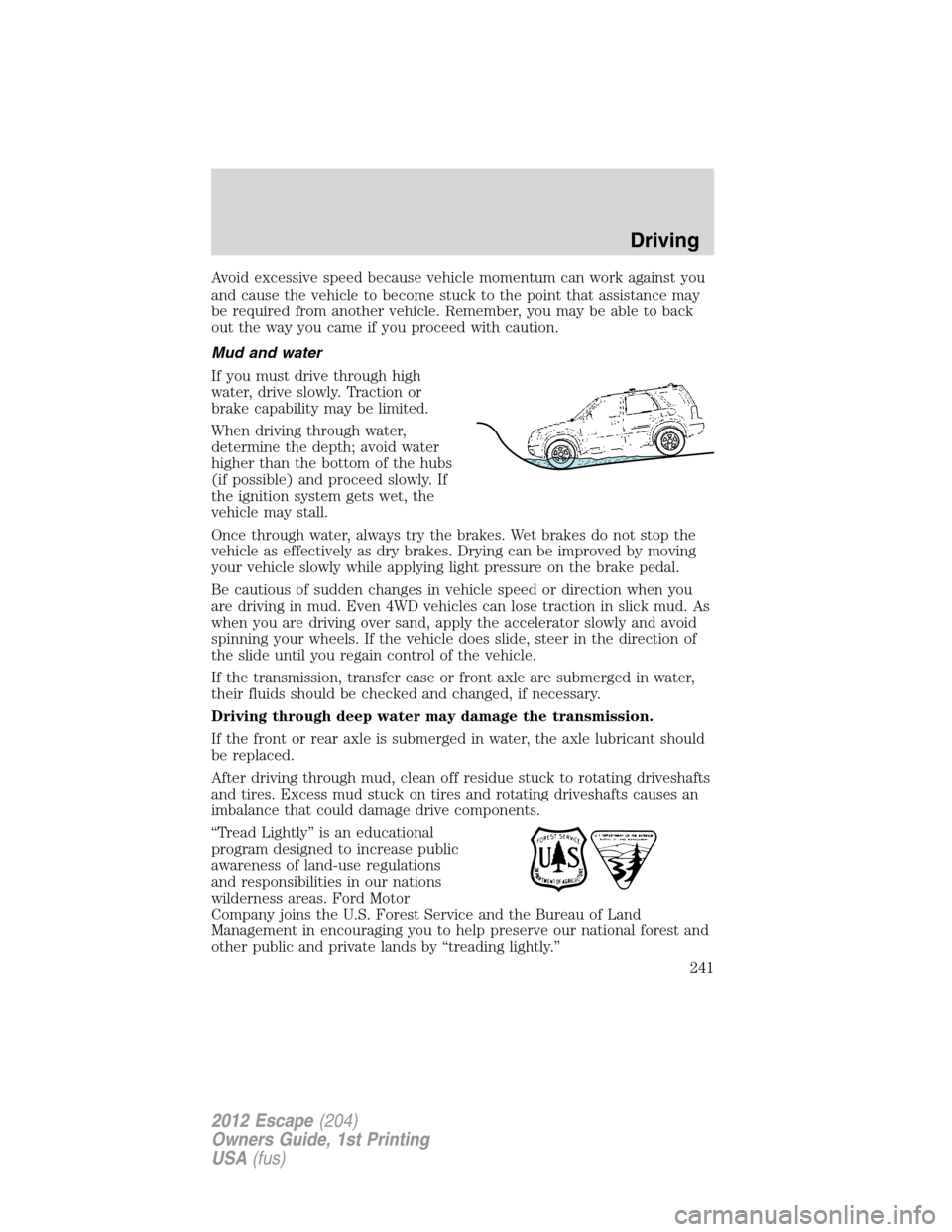Page 219 of 361

Switching off traction control
If the vehicle is stuck in snow, mud or sand, and seems to lose engine
power, switching off the traction control features of the AdvanceTrac�
with RSC�system may be beneficial because the wheels are allowed to
spin. This will restore full engine power and will enhance momentum
through the obstacle. To switch off the traction control, press the
traction control off button. Full features of the stability control system
can be restored by pressing the traction control off button again, or by
turning off and restarting the engine.
If you switch off the traction control, the stability control “OFF” light will
illuminate steadily. Pressing the stability control off button again will turn
off the stability control “OFF” light.
In R (Reverse), ABS and the engine and brake traction control features
will continue to function; however, ESC and RSC�are disabled.
AdvanceTrac�with RSC�Features
Button
functionsStability
control
light
RSC�/
ESC/
Traction
controlStability
control
“OFF”Trailer
sway
Default at
start-upIlluminated
during bulb
checkEnabledIlluminated
during bulb
checkEnabled
Button pressed
momentarilyNot
IlluminatedEnabled
1Illuminated
solidEnabled
Button pressed
again after
deactivationNot
illuminatedEnabledNot
illuminatedEnabled
2
1
When the AdvanceTrac�button is pressed momentarily, traction
control is disabled.
2When the AdvanceTrac�button is pressed and held for more than five
seconds, trailer sway control is disabled.
Driving
219
2012 Escape(204)
Owners Guide, 1st Printing
USA(fus)
Page 241 of 361

Avoid excessive speed because vehicle momentum can work against you
and cause the vehicle to become stuck to the point that assistance may
be required from another vehicle. Remember, you may be able to back
out the way you came if you proceed with caution.
Mud and water
If you must drive through high
water, drive slowly. Traction or
brake capability may be limited.
When driving through water,
determine the depth; avoid water
higher than the bottom of the hubs
(if possible) and proceed slowly. If
the ignition system gets wet, the
vehicle may stall.
Once through water, always try the brakes. Wet brakes do not stop the
vehicle as effectively as dry brakes. Drying can be improved by moving
your vehicle slowly while applying light pressure on the brake pedal.
Be cautious of sudden changes in vehicle speed or direction when you
are driving in mud. Even 4WD vehicles can lose traction in slick mud. As
when you are driving over sand, apply the accelerator slowly and avoid
spinning your wheels. If the vehicle does slide, steer in the direction of
the slide until you regain control of the vehicle.
If the transmission, transfer case or front axle are submerged in water,
their fluids should be checked and changed, if necessary.
Driving through deep water may damage the transmission.
If the front or rear axle is submerged in water, the axle lubricant should
be replaced.
After driving through mud, clean off residue stuck to rotating driveshafts
and tires. Excess mud stuck on tires and rotating driveshafts causes an
imbalance that could damage drive components.
“Tread Lightly” is an educational
program designed to increase public
awareness of land-use regulations
and responsibilities in our nations
wilderness areas. Ford Motor
Company joins the U.S. Forest Service and the Bureau of Land
Management in encouraging you to help preserve our national forest and
other public and private lands by “treading lightly.”
Driving
241
2012 Escape(204)
Owners Guide, 1st Printing
USA(fus)
Page 242 of 361

Driving on hilly or sloping terrain
Although natural obstacles may make it necessary to travel diagonally up
or down a hill or steep incline, you should always try to drive straight up
or straight down.Avoid driving crosswise or turning on steep
slopes or hills.A danger lies in losing traction, slipping sideways and
possibly rolling over. Whenever driving on a hill, determine beforehand
the route you will use. Do not drive over the crest of a hill without
seeing what conditions are on the other side. Do not drive in reverse
over a hill without the aid of an observer.
When climbing a steep slope or hill,
start in a lower gear rather than
downshifting to a lower gear from a
higher gear once the ascent has
started. This reduces strain on the
engine and the possibility of stalling.
If you do stall out, Do not try to
turnaround because you might roll
over. It is better to back down to a
safe location.
Apply just enough power to the wheels to climb the hill. Too much
power will cause the tires to slip, spin or lose traction, resulting in loss of
vehicle control.
Descend a hill in the same gear you
would use to climb up the hill to
avoid excessive brake application
and brake overheating. Do not
descend in neutral; instead,
disengage overdrive or manually
shift to a lower gear. When
descending a steep hill, avoid
sudden hard braking as you could
lose control. When you brake hard,
the front wheels cannot turn and if
they are not turning, you will not be
able to steer. The front wheels have to be turning in order to steer the
vehicle.
Since your vehicle has anti-lock brakes, apply the brakes steadily. Do not
“pump” the brakes.
Driving
242
2012 Escape(204)
Owners Guide, 1st Printing
USA(fus)